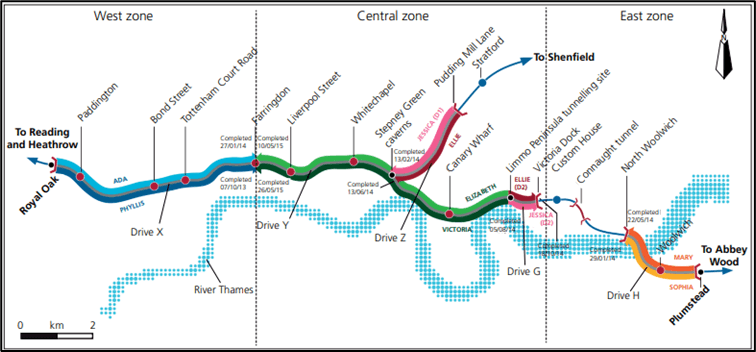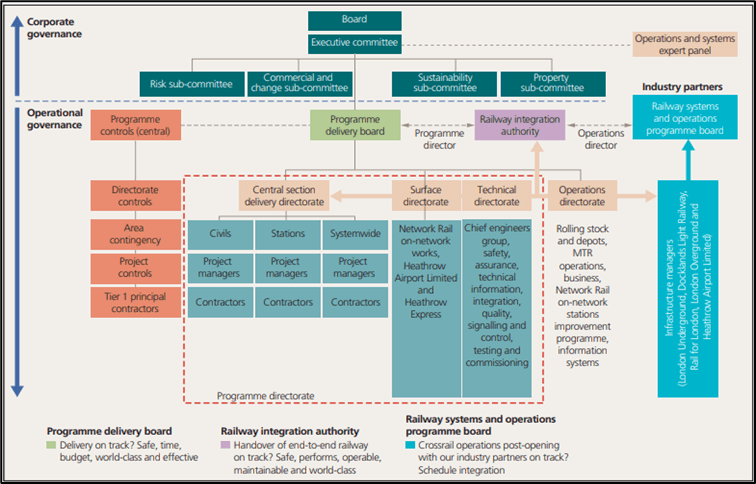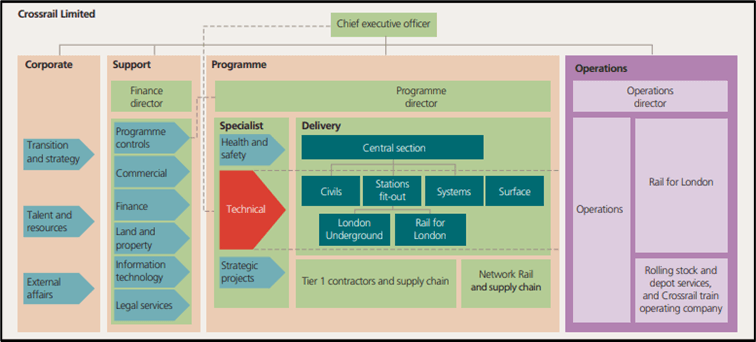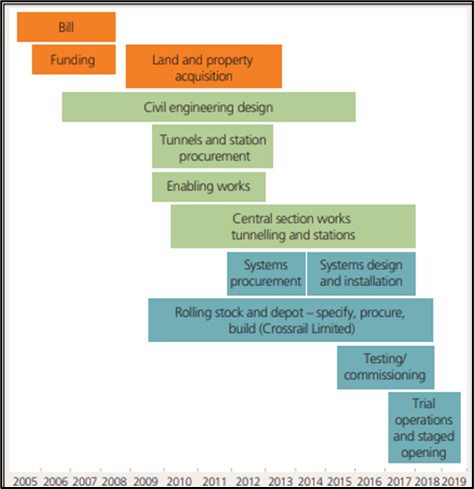- Managing Programs And Portfolios
- 1. Introduction: Managing Programs And Portfolios
- 2. Task Objectives
- 2.4. Importance of Projects, Programmes & Portfolios; Management & Organisational Strategy
- 2.5. Using Projects, Programmes Portfolios and Organisational Strategy in the Successful Completion of the Crossrail Project
- 2.6. Importance of Business Case with Successful Programme Management
Managing Programs And Portfolios
1. Introduction: Managing Programs And Portfolios
A project is described as "a temporary endeavour to generate a unique product, service, or result" by the Project Management Institute (PMI) (Pmo.uchicago.edu, 2023). According to Oltmanns (2008), a programme is "a temporary framework of interrelated initiatives managed jointly that gives advantages and contributes to the attainment of objectives." When several connected projects need to be handled jointly to accomplish a single objective, programs are used. Organisations can increase efficiency, minimise duplication of work, and align project outcomes with organisational objectives by coordinating several projects inside a programme. A portfolio is "a grouping of programmes and projects to make administration of them easier to achieve organisational goals." Organisations may more efficiently manage their resources and prioritise efforts depending on how well they connect with their overall objectives thanks to portfolios, which give them a comprehensive perspective of all of their projects and programmes.
Struggling to meet word count? With our Help with Assignment, get detailed, relevant, and well-structured content that meets all requirements. Get your quote now!
Effective governance is necessary for managing projects, programmes, and portfolios, as is knowledge of the importance of programme and portfolio management. Organisations can accomplish better resource management, risk management, and strategic alignment in particular with the aid of programme and portfolio management. Program and portfolio management were essential to the successful delivery of London's Elizabeth Line when planning the Crossrail programme. The Elizabeth Line, a 2009 railway construction project, sought to greatly improve public transportation in London by expanding capacity and cutting down on travel times around the city. The project was anticipated to carry over 200 million passengers annually, cutting travel times and relieving congestion on the current rail and subway services, with 10 new stations in central London and 40 stations overall. One of the greatest infrastructure projects ever undertaken, it will completely overhaul the transportation system in London and the surrounding environments (Wright, Palczynski & ten Have 2017).

Figure 1: Geographical Split of Tunnelling and Stations Contracts
2. Task Objectives
2.1. Role of Governance and Methods to Deliver Programmes and Portfolios in an Effective Way
To manage risks, and improve performance, organisations must develop project governance. Project governance includes making decisions and taking responsibility for an organisation's overall performance and direction as well as for the rules, procedures, benchmarks, and frameworks that specify and carry out organisational goals (Edition, 2018). Müller, Martinsuo & Blomquist (2008), asserts that effective governance and programme management are crucial elements of successful businesses because they enable them to finish projects on schedule, within budget, and following client demands. Yet before the project starts, a large amount of money must be spent on setting up a governance framework (Derakhshan, Turner & Mancini, 2019). Nonetheless, several advantages have been noted, including a thorough accountability process, representation of stakeholder connections, managing and resolving issues, publishing information, and open communication (Garland, 2009).
The platform provided by project governance allows for the collection and reporting of information to stakeholders, ensuring that communication plans are clear, current, and successfully carried out. Direct and regular reporting also encourages productivity improvements and satisfies stakeholder demands. Program management governance offers a framework for decision-making that aids organisations in making the best use of their resources to meet their goals (Too & Weaver, 2014). A thorough project governance plan should be created and put into place at the outset of the project to satisfy the particular needs of each project and programme. To establish, maintain, and administer project governance, Alie (2015) identified eight key components or functions, including the governance model, method of accountability and responsibility, stakeholder engagement, stakeholder communication, method of reporting and meetings, risk management, assurance, and monitoring and controlling processes and procedures.
Organisations must have excellent governance and programme management to accomplish their goals, keep up their competitiveness, and effectively manage risks. According to Derakhshan, Turner, and Mancini (2019), creating a governance system is a difficult process that demands considerable upfront investment. Nonetheless, there are numerous advantages to instituting project governance. A thorough process of accountability, a clear depiction of the relationships, duties, and obligations of stakeholders, effective management and resolution of challenges, and open communication are the four main advantages of project governance as outlined by Garland (2009).

Figure 2: Governance Map
2.2. Role of Governance in the Successful Delivery of the Crossrail Programme
A significant transportation initiative in London called Crossrail proposes to build a new train system that will run from east to west through the metropolis. The project was a sizable enterprise that encountered numerous difficulties during its existence. The proper execution of the Crossrail Projects has depended heavily on governance. Using pertinent academic research and industry sources, this section will analyse the function of governance in the project. The framework it offers for decision-making, risk management, and stakeholder involvement makes governance an essential part of project management (Edition, 2018). The Department for Transport, Transport for London, and the Mayor of London are just a few of the numerous stakeholders in the complicated governance system that oversees the Crossrail Programme. The Crossrail Board, which is in charge of giving the project strategic direction and control, oversees the programme (Muruganandan et al.,2022). Each stakeholder group is represented on the Board, which is presided over by the mayor of London.

Figure 3: Governance structure of Crossrail project
The Crossrail Program's governance structure has played a key role in guaranteeing the project's successful completion. To guarantee that the project achieves its goals, it has established a platform for efficient stakeholder involvement and communication. For instance, the governance structure has made it possible for stakeholders to meet often, which has made it possible to quickly identify and address difficulties. This has aided in the effective control of dangers, timely completion of projects, and efficient use of resources (Müller, Zhai & Wang, 2017). Moreover, the governance structure has assisted in managing project-related risks. There have been several difficulties with the Crossrail Project, such as delays, cost overruns, and technical problems. Effective risk management made possible by the governance framework allows for the prompt identification and mitigation of risks (Muruganandan et al.,2022).
A framework for decision-making has also been provided by the governance structure of the Crossrail Programme, ensuring that resources are used effectively and efficiently to meet project objectives. The governance framework has made it possible to create and implement a thorough project governance plan that encompasses the eight key elements of project governance that Alie defined (2015). The governance model, accountability and responsibility methods, stakeholder involvement, stakeholder communication, reporting and meeting methods, risk management, assurance, and monitoring and regulating processes and procedures are some of these components.
2.3. Advantages of Using Governance Framework in Crossrail Programme
The Crossrail Project is a lengthy, intricate, and multifaceted infrastructure project that involves many parties. A governance framework is required for the project's effective completion. The Crossrail Programme benefits from a governance framework in several ways.
- Enhances Accountability: The governance framework makes sure that everyone is held responsible for their duties (Kerzner, 2017). It makes sure that everyone is working towards the same goals by defining precisely who is in charge of making decisions and managing risks.
- Improves Decision-Making: A governance framework offers an organised method for making decisions (Edition, 2018). It describes the factors to consider when making decisions, how decisions are made and the roles and duties of decision-makers. This guarantees that choices are made using impartial standards and with the input of all pertinent parties.
- Improves Risk Management: A governance framework offers a methodical approach to locating and managing risks (Eisenhardt, 1989). It describes the steps involved in risk management, the duties assigned to risk managers, and the standards used to assess risks. This guarantees that risks are efficiently controlled, lowering the possibility of project failure.
- Ensures Compliance: Compliance is ensured by the governance architecture, which also guarantees adherence to legal and regulatory obligations. It describes the rules and regulations that the project must abide by as well as the stakeholder's obligations to ensure compliance (Edition, 2018).
2.4. Importance of Projects, Programmes & Portfolios; Management & Organisational Strategy
2.4.1. Projects, Programmes and Portfolios
Programs, projects, and portfolios are essential to the success of an organisation. Projects are short-term endeavours designed to produce original goods, services, or outcomes (Edition, 2018). Whereas portfolios are sets of programmes and projects managed jointly to facilitate their management to accomplish organisational objectives, programmes are collections of linked projects handled collectively to achieve organisational goals (McMullan et al., 2003). It is impossible to overstate the value of projects, programmes, and portfolios. They enable firms to manage resources, reduce risks, and accomplish their strategic objectives (Stroustrup, 1988). While project management helps to guarantee that individual projects are finished on schedule, within budget, and to the necessary quality standards, programmes and portfolios assist firms in aligning their projects with their larger company strategy and objectives (Lycett, Rassau & Danson, 2004). An extensive understanding of the underlying ideas, tools, and methodologies is necessary for the effective management of projects, programmes, and portfolios. Strong leadership, efficient communication, and cooperation between all parties involved are also necessary. Organisations can increase their chances of success, accomplish their strategic objectives, and provide value to their stakeholders by adopting a systematic approach to project, programme, and portfolio management.
2.4.2. Projects, Programmes and Portfolios and Organisational Strategy
The organisational strategy includes portfolios, projects, and programmes as essential elements. They are essential in ensuring that an organisation's goals are accomplished successfully and effectively. Projects assist in achieving particular aims and objectives within a predetermined time and financial limit. Portfolios offer a strategic method for managing a collection of programmes and projects to meet organisational objectives, whereas programmes give a framework for managing numerous interconnected projects to accomplish a shared purpose.
The Project Management Institute (PMI) asserts that aligning projects, programmes, and portfolios with an organisation's strategy promotes successful resource allocation, risk management, and stakeholder value delivery (Edition, 2018). Organisations may adapt to shifting market conditions, take advantage of new possibilities, and maintain competitiveness with the aid of effective project, programme, and portfolio management. The effective and efficient use of the organisation's resources to provide value to its stakeholders is further ensured through project, programme, and portfolio management. It offers a framework for choosing how to allocate resources, manage risks, and realise benefits (Oltmann, 2008).
2.4.3. Importance of Pmo (Project Management Office) in Achieving Strategic Targets with Programme Management
Project management offices (PMOs) assist in project and programme management activities, which is a crucial function they play in enterprises (Pietinen, 2019). PMOs are now widely acknowledged as being important for three reasons: they offer a centralised framework for planning and carrying out projects, and they raise the maturity of project management. PMOs also aid in setting up governance frameworks and keeping track of how well strategic objectives are being achieved. PMOs are crucial in the context of programme management, where several interconnected projects are overseen jointly (Pietinen, 2019). Research shows that PMO-equipped firms are more likely to meet their strategic objectives and complete projects on schedule, within budget, and to the required level of quality (Basten, Joosten & Mellis, 2011). Moreover, a strong PMO can promote improved teamwork and communication as well as more efficient risk management.
A PMO can also offer insightful information about capacity planning and resource allocation, allowing for improved prioritising and execution of projects within a programme. This can assist businesses in ensuring that projects support the accomplishment of long-term objectives and are in line with their strategic objectives.
2.5. Using Projects, Programmes Portfolios and Organisational Strategy in the Successful Completion of the Crossrail Project
The Elizabeth Line and Crossrail projects are significant infrastructural initiatives to enhance London's public transit. It entails building a new railway line that will be over 100 km long and have 41 stops; it is anticipated to greatly reduce travel times and boost capacity for city commuters (Archive.org, 2022). Effective project, programme, and portfolio management, as well as alignment with organisational strategy, are essential for the successful completion of a project of this size. Application of information, skills, tools, and procedures is part of project management to achieve project requirements (Edition, 2018). The Crossrail project involves a variety of projects, including the building of tunnels, stations, and tracks, each of which needs a unique project management approach to be completed on schedule, within budget, and to the needed quality standards. To guarantee the successful completion of each project component, the project management team must also manage risks, stakeholder engagement and communication, and project scope adjustments.
Programme management entails overseeing related projects that share a common strategic objective (Edition, 2018). In the context of the Crossrail project, programme management entails coordinating the various projects necessary to build the Elizabeth Line to make sure they are in line with the overarching objective of enhancing London's public transportation. The identification and management of interdependencies, the coordination of projects with the overall programmememe objectives, and the control of programmememe risks and issues are all included in programmememe management. Managing a group of programmes and initiatives under a portfolio helps an organisation achieve its goals (Edition, 2018). The Crossrail project is a component of Transport for London's (TfL) comprehensive portfolio of initiatives focused on enhancing London's transportation system. The portfolio management team must make sure that the Crossrail project contributes to the attainment of and is in line with TfL's broader strategic goals. This calls for efficient resource allocation, the ranking of projects according to strategic objectives, and portfolio-wide risk management.
An organisation's general direction and focus are determined by its organisational strategy, which also outlines how it will accomplish its long-term objectives (Johnson et al., 2020). The Crossrail project must be in line with TfL's overarching strategic objectives for enhancing London's transportation system to be completed successfully. To ensure that the project is in line with the organisation's long-term objectives, good communication and coordination between the project, programme, and portfolio management teams and TfL's executive team are required. The establishment of a Project Management Office (PMO) can help with programme management to accomplish strategic goals. To ensure that projects and programmemes are in line with strategic goals and that the necessary resources and procedures are in place to help them be achieved, the PMO provides centralised oversight, support, and advice for project and programme management operations (Edition, 2018). The PMO may offer essential monitoring and direction for the Crossrail project to ensure that the many projects and programmes involved are in line with TfL's overarching strategic goals.
Effective project, programme, and portfolio management is necessary for the Crossrail project's successful completion, as is alignment with TfL's broad strategic goals. This calls for the effective management of resource allocation, project prioritisation based on strategic objectives, and risk management throughout the entire portfolio. Additionally, the establishment of a PMO can offer the essential monitoring and direction to guarantee that the project is in line with TfL's overall strategic goals and that the relevant tools and procedures are in place to meet those goals.

Figure 4: High-level schedule
2.6. Importance of Business Case with Successful Programme Management
A business case is a document that justifies a project or programme and includes information on its costs, advantages, risks, and prospects (Edition, 2018). A strong business case is necessary for effective programme management because it offers a structured and unambiguous method for decision-making throughout the programme. The significance of a business case for effective programme management will be covered in this section.
First off, a business case offers a concise justification for the programme, together with the results and advantages anticipated. This makes it easier to guarantee that the plan will be cost-effective and that it will be in line with the organisation's overall strategy and objectives (Edition, 2018). The program manager can proactively manage risk and spot possibilities for improvement throughout the programme's lifetime thanks to the business case's detailed description of the risks and opportunities related to the project. Second, a business case gives the programme a baseline, enabling progress to be monitored against anticipated results and benefits. This enables the programme manager to spot any variations from the initial plan and, if necessary, take remedial action (Edition, 2018). It also serves as a foundation for continuous programme success evaluation and the identification of lessons learned for subsequent programmes.
Thirdly, a business case assists in making sure that the programme has adequate money and staffing. It offers a foundation for allocating resources to the project and for ranking competing demands in order of importance. This is crucial for effective programme management since a lack of resources can cause delays, cost overruns, and a decline in the calibre of the programme (Edition, 2018). Fourth, a business case offers a foundation for stakeholder participation and communication throughout the course of a programme. It describes the advantages of the programme and the obligations of stakeholders, fostering support and involvement (Edition, 2018). As a result, stakeholders are informed and involved throughout the course of the programme. It also serves as a foundation for ongoing communication and reporting on the program's progress.
A business case offers a foundation for continuous programme success evaluation, including the achievement of anticipated results and benefits, as well as the management of risks and opportunities. This makes it easier to make sure that the programme is providing the intended value and that any problems are found and dealt with right away.
2.6.1. Importance of Business Case in the Context of Crossrail Project
A significant infrastructure initiative to enhance London's public transit is the Crossrail project. The project entails building a new railway line that will be approximately 100 km long and have 41 stops. It is anticipated to greatly reduce travel times and boost capacity for city commuters (Archive.org, 2022). A crucial part of the Crossrail project, the business case provides a framework for decision-making and guarantees that the project stays in line with Transport for London's strategic objectives (TfL). The business case provides a framework for determining if the project is a viable investment by outlining the justification for the initiative, together with the benefits and expenses connected with the project (HM Treasury, 2018). In the case of the Crossrail project, the business case covers the project's strategic goals, as well as the advantages it will have for the economy and society, as well as its expected costs and the completion date.
Moreover, the business case offers a framework for making decisions during the course of the project. It guarantees that the project stays in line with TfL's strategic goals and that any adjustments made to the project's scope or time frame are made in line with those goals (TfL, n.d.). The business case offers a method for determining the project's ongoing viability, ensuring that TfL can continue to afford to invest in it. The business case offers a foundation for obtaining finance for the project as well. It enables TfL to convincingly argue for funding from the government and other stakeholders by highlighting the project's economic and social benefits as well as its potential return on investment.
Conclusion
The process of organising, carrying out, overseeing, and regulating a project while staying within its parameters is known as project management. The three parts that make it up are projects, programmes, and portfolios. The most advanced form of project management, portfolios include all of the work done by the organisation. Successful project, programme, and portfolio management is essential to an organisation's success because it helps to manage stakeholders, risks, and resources while ensuring alignment with corporate goals. Organisations may accomplish their objectives, boost their competitiveness, and increase their overall success by using a systematic and integrated approach to project, programme, and portfolio management.
References
Alie, S. S. (2015). Project governance:# 1 critical success factor. Project Management Institute.
Archive.org. (2022). Direct Elizabeth line services into central London from Reading, Heathrow, and Shenfield start today. [Online] Available at: https://web.archive.org/web/20221228172235/https://www.crossrail.co.uk/news/articles/direct-elizabeth-line-services-into-central-london-from-reading-heathrow-and-shenfield-start-today. [Accessed On: 30 March 2023]
Basten, D., Joosten, D., & Mellis, W. (2011). Managers' perceptions of information system project success. Journal of Computer Information Systems, 52(2), 12-21.
Derakhshan, R., Turner, R., & Mancini, M. (2019). Project governance and stakeholders: a literature review. International Journal of Project Management, 37(1), 98-116.
Edition, P. S. (2018). A guide to the project management body of knowledge. Project Management Institute. Pensylvania.
Eisenhardt, K. M. (1989). Agency theory: An assessment and review. Academy of management review, 14(1), 57-74.
Garland, R. (2009). Project Governance: A practical guide to effective project decision making. Kogan Page Publishers.
Johnson, G., Whittington, R., Regnér, P., Angwin, D., & Scholes, K. (2020). Exploring strategy. Pearson UK.
Kerzner, H. (2017). Project management: a systems approach to planning, scheduling, and controlling. John Wiley & Sons.
Lycett, M., Rassau, A., & Danson, J. (2004). Programme management: a critical review. International journal of project management, 22(4), 289-299.
McMullan, M., Endacott, R., Gray, M. A., Jasper, M., Miller, C. M., Scholes, J., & Webb, C. (2003). Portfolios and assessment of competence: a review of the literature. Journal of advanced nursing, 41(3), 283-294.
Müller, R., Martinsuo, M., & Blomquist, T. (2008). Project portfolio control and portfolio management performance in different contexts. Project management journal, 39(3), 28-42.
Müller, R., Zhai, L., & Wang, A. (2017). Governance and governmentality in projects: Profiles and relationships with success. International journal of project management, 35(3), 378-392.
Muruganandan, K., Davies, A., Denicol, J., & Whyte, J. (2022). The dynamics of systems integration: Balancing stability and change on London's Crossrail project. International Journal of Project Management, 40(6), 608-623.
Oltmann, J. (2008). Project portfolio management: how to do the right projects at the right time. In PMI® Global Congress.
Pietinen, K. (2019). Project Management Office: The process of creating a PMO concept.
Pmo.uchicago.edu. (2023) . Project Definition and Initiation.[Online] Available at: Project Definition | Project Management Office (uchicago.edu) [Accessed On: 30 March 2023]
Project Management Institute. (2018). Guide to the project management body of knowledge. Project management inst.
Stroustrup, B. (1988). What is object-oriented programming?. IEEE software, 5(3), 10-20.
Too, E. G., & Weaver, P. (2014). The management of project management: A conceptual framework for project governance. International journal of project management, 32(8), 1382-1394.
Transport for London (TfL). (n.d.). Budget and Business Plan. [Online] Available at: https://tfl.gov.uk/corporate/publications-and-reports/business-plan. [Accessed On: 30 March 2023]
Treasury, H. M. (2018). Spring statement 2018.
Wright, S., Palczynski, R., & ten Have, P. (2017, November). Crossrail programme organisation and management for delivering London’s Elizabeth line. In Proceedings of the Institution of Civil Engineers-Civil Engineering (Vol. 170, No. 6, pp. 23-33). Thomas Telford Ltd.



